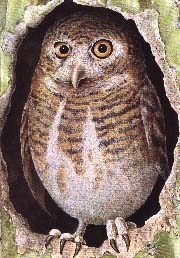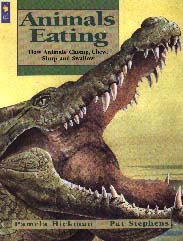|
________________
CM . . . .
Volume VII Number 21 . . . . June 22, 2001
excerpt: Imagine eating a big meal and then not eating again for a year. That's what an anaconda does. What if you lived in the desert and never had a drink of water, like a kangaroo rat? Or you might live entirely on liquids, the way a vampire bat does. And what if you caught your food with your tongue like a chameleon can, or used your eyeballs to help you swallow, the way a toad does?  Form follows function. It's a mantra drilled into biology undergraduates everywhere--and the
lesson Pamela Hickman delivers to younger learners with her book, Animals Eating: How
Animals Chomp, Chew, Slurp and Swallow. The book explores how the feeding mechanisms of
different animals suit both habit and habitat. Incidentally, it's a principle that applies to writing
informative books as well: the book must be uniquely suited to its purpose--that of conveying
information.
Form follows function. It's a mantra drilled into biology undergraduates everywhere--and the
lesson Pamela Hickman delivers to younger learners with her book, Animals Eating: How
Animals Chomp, Chew, Slurp and Swallow. The book explores how the feeding mechanisms of
different animals suit both habit and habitat. Incidentally, it's a principle that applies to writing
informative books as well: the book must be uniquely suited to its purpose--that of conveying
information.
The writer of several nature activity books for children, Hickman shapes her language accordingly. She engages readers by talking directly, conversationally, to them, and by including the facts and extreme trivia dear to their hearts (crocodiles grow up to 3000 teeth in a lifetime, for example). To facilitate understanding, she reconfigures the unfamiliar into the commonplace: "Do you like leftovers?" she asks in introducing scavengers, and of the anaconda, "Imagine eating a big meal and then not eating again for a year." Throughout the book, Hickman inserts activities to illustrate points and explain how things work. The tongue trapper, made of velcro, elastic bands and a stir stick, effectively mimics the tongue action of a toad. Similarly, the bag-o'-gravel model elegantly illustrates how a bird's gizzard digests seeds. The multiple-choice quizzes and other exercises, though--including one in math--resemble schoolwork a bit too closely. Form follows function?? With the format of the book, her grasp of the principle begins to unravel. The overview outlines the contents and sets up readers for what's to come. The approach is a good one, but unworkable if questions remain unanswered and expectations go unfulfilled: the kangaroo rat, who "lived in the desert and never had a drink of water" makes its sole appearance in the introduction, and the mystery of how a toad's eyeballs help it swallow goes unsolved. The text that follows is possibly, loosely, organized to follow the "chomp, chew, slurp and swallow" of the title. However, the sections are not so labeled, and rely rather weakly instead on typography and design to mark the transitions. The sections lack focus as well. Most contain little more than a list of token examples and an introductory blurb. The boxes titled "If you were a [insert animal]" deliver some detail, but little depth. The choice of animal for each box seems arbitrary, as do the decisions surrounding what stays in the text and what goes into other boxes containing miscellany: in many cases, boxed information is interchangeable with body content. Large picture spreads and lots of boxes dominate the design. The drawings, mostly animal close-ups, show remarkable detail and extensive labeling. Unfortunately, this thoroughness serves to highlight the one labeling omission, on the diagrams of human teeth. The subdued tones in the watercolours are a refreshing departure from the electric brights commonly used to draw kids to science; might it then, work against the book? The huge pictures and our world's amazing diversity of animals mean space is at a premium--and thus, repetition and wordiness costly. Closer editing is an easy remedy for these occurrences, as well as for a few typos and lapses in grammar and punctuation. Another look at the overall plan, itself, would also have served the book well. In a book meant to convey information, form must follow function. Not Recommended. Cora Lee is a Vancouver writer and editor.
To comment on this title or this review, send mail to cm@umanitoba.ca.
Copyright © the Manitoba Library Association.
Reproduction for personal use is permitted only if this copyright notice
is maintained. Any other reproduction is prohibited without
permission.
Published by
TABLE OF CONTENTS FOR THIS ISSUE - June 22, 2001.
AUTHORS |
TITLES |
MEDIA REVIEWS |
PROFILES |
BACK ISSUES |
SEARCH |
ORDER |
CMARCHIVE |
HOME
|
